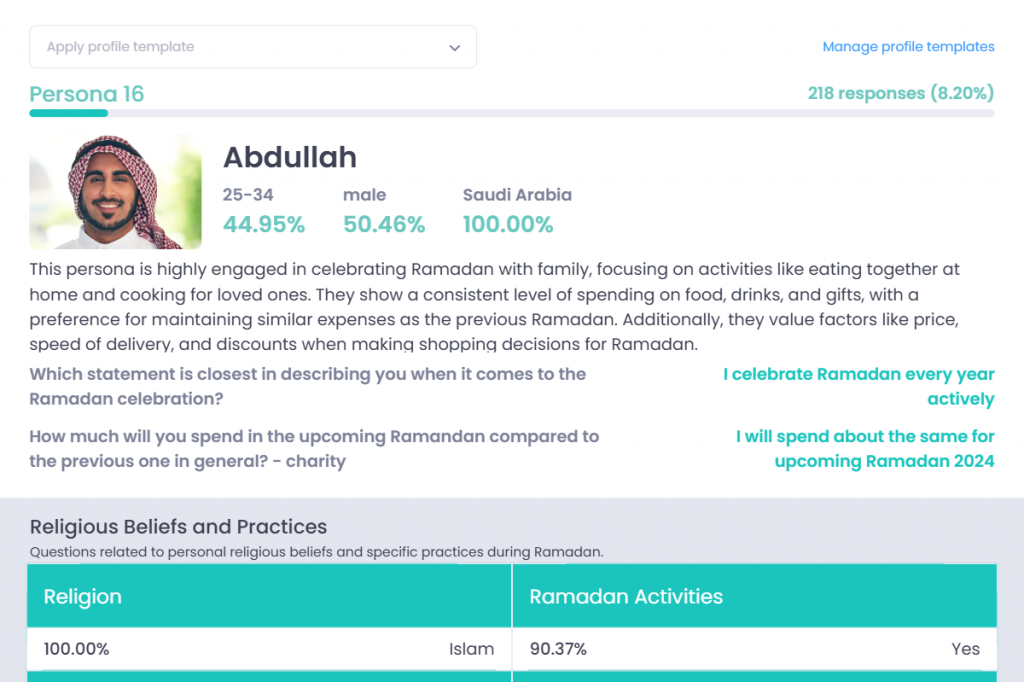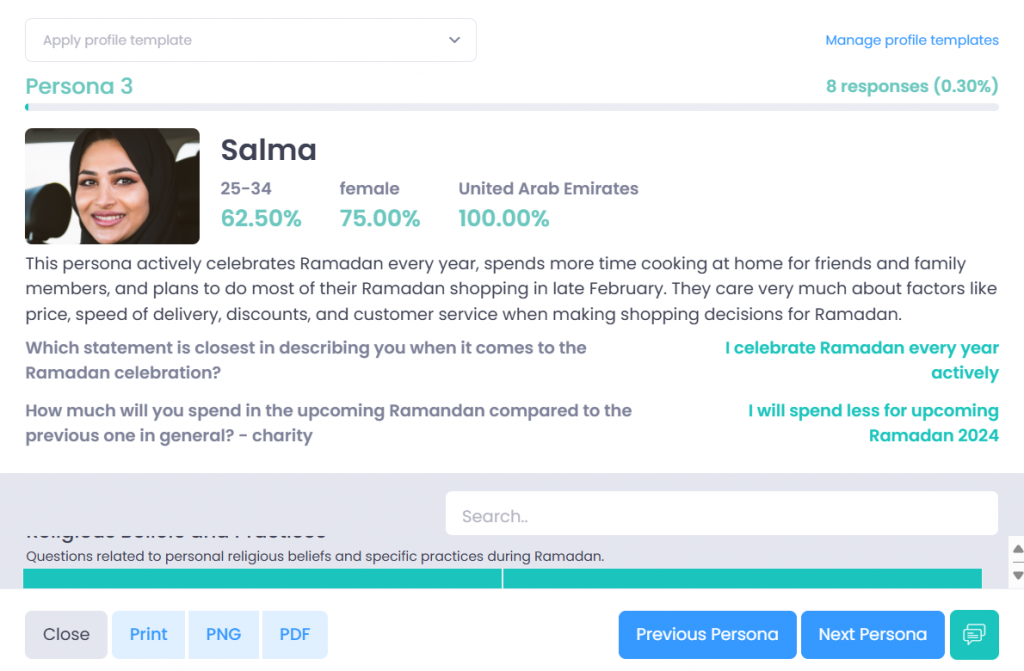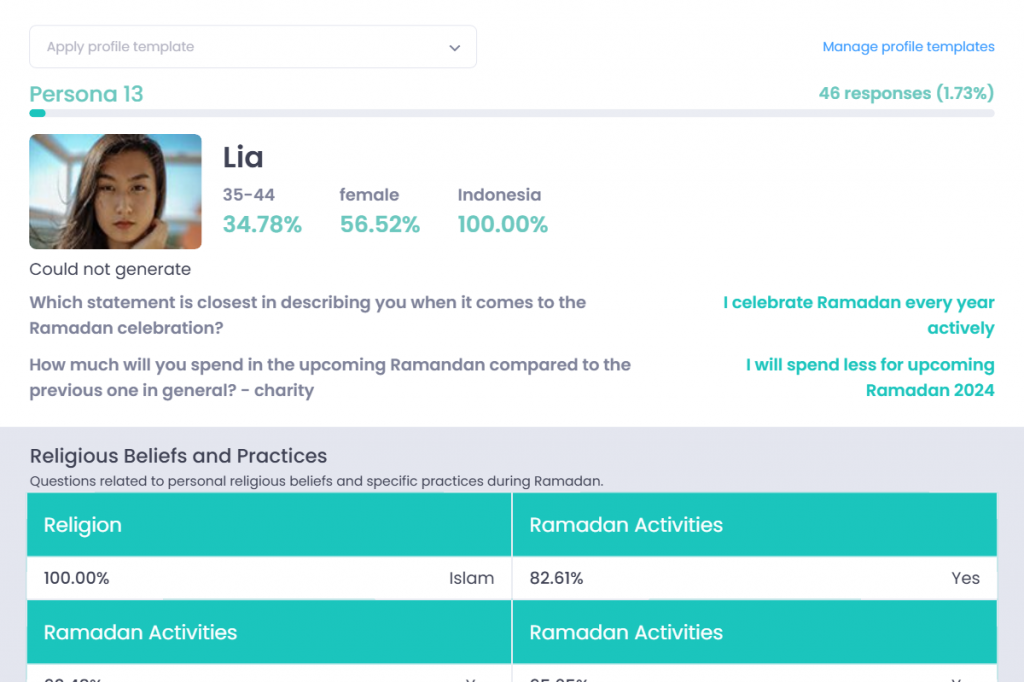
TGM Ramadan Insights Banner (2024) (TGM Global Ramadan Insights 2024 | Consumer Data and Statistic (tgmresearch.com))
As an undergraduate university student, I often find myself investigating fields that I find interesting or challenging. One of which is the innovative exploration of complex datasets. Recently, I had the opportunity to work with data from the TGM Research 2024 Ramadan Global Study with my mentor, Dr. Bernard J. Jansen. This study provided fascinating insights into various aspects of Ramadan experiences across different demographics. However, transforming this extensive data into meaningful and actionable personas was challenging. Here’s how I leveraged Survey2Persona to bring the data to life and gain deeper insights into user behavior.
Step 1: Exploring the TGM Research Ramadan Data
The TGM Research Ramadan Global Study offers a comprehensive look at how people across different countries, including Indonesia, Egypt, Saudi Arabia, and the UAE, experience and celebrate Ramadan. The dataset includes information on fasting habits, religious practices, spending patterns, etc. Here’s a brief overview of what the dataset contained:
– Demographics: Age, gender, location.
– Religious Practices: Celebration habits during Ramadan.
– Preferences: Favorite dishes, shopping preferences, dining preferences, and family relationships.
– Spending Patterns: Expenditure on food, gifts, and charity during Ramadan.
– Overview of the future: Feelings on the upcoming year and assumptions about the upcoming Ramadan
Step 2: Data Cleaning in Excel
Before diving into persona creation, cleaning and organizing the data was essential. Using Excel, my mentor and I performed the following tasks:
– Data Validation: Ensured all demographic fields were consistently formatted and disregarded responses of religious beliefs not Islam.
– Error Checking: Identified and corrected any obvious errors or inconsistencies in the data.
–Translation: Translated Arabic words into English to avoid errors with S2P.
– Summary Statistics: Created summary statistics to understand the distribution of responses.
Step 3: Uploading Data to Survey2Persona
With a clean dataset in hand, the next step was to upload it into Survey2Persona. The platform supports various formats, and uploading the Excel file was straightforward.
– Upload Process: Navigate to the Survey2Persona dashboard and select the option to upload data.
– File Selection: Choose the cleaned Excel file and let Survey2Persona handle the rest.
Survey2Persona quickly processed the data, making it ready for persona creation.
Step 4: Generating Personas
Survey2Persona offers two main methods for creating personas: ‘ Machine-Learning Segmentation’ and ‘Comprehensive Persona Creation’. For this project, I chose the second method to capture the diversity of the data fully.
1. Defining Criteria:
– Demographic Focus: Age, country, and gender to highlight different cultural contexts.
– Behavioral Patterns: Spending habits and consumption preferences.
– Religious Practices: Level of interest in Ramadan festivities.
2. Persona Creation:
– Persona Profiles: Survey2Persona generated detailed personas based on the criteria. Each persona had a unique profile, including demographics, behavior, and preferences.
– Customization: I could tweak the categories the generated personas fall under to better align with the key insights from the data.
Example: One persona, “Abdullah,” represents a young adult male from Saudi Arabia who celebrates Ramadan every year actively and highlights his spending for the upcoming Ramadan to be the same as the last.

Example of Generated Persona
Step 5: Asking Personas Questions
I took a step further with the created personas by using them to ask targeted questions to gain deeper insights. This step was crucial in understanding the users.
Questions Posed:
– Spending: “How do you allocate your budget during Ramadan?”
Chatting with the generated persona about his budgeting
– Religious Activities: “What motivates your mosque attendance frequency?”
Chatting with the generated persona about his mosque attendance
– Media Preferences: “What type of media content do you prefer during Ramadan?”
Chatting with the generated persona about his media preferences
The previous images show how the generated persona, Abdullah, responded to the questions posed. Other generated personas were questioned similarly to gain more insights on these topics.


Examples of other generated personas showcasing diversity
Insights Gained:
– Spending Priorities: Personas indicated varying spending priorities, with some focusing on gifts and others on charity, food, entertainment, etc.
– Religious Motivation: The frequency of mosque attendance was influenced by both personal faith and community involvement.
– Content Preferences: Media consumption patterns revealed a preference for all religious, entertainment, and food content, depending on age and lifestyle.
Step 6: Brainstorming Applications
The final step was brainstorming ways to apply the insights gained from the personas to real-world scenarios. These actionable insights helped tailor strategies for different aspects of Ramadan experiences.
Applications:
– Marketing Strategies: Using personas to design targeted marketing campaigns that resonate with different demographic segments.
– Content Development: Creating content that aligns with the media preferences of various personas.
– Community Programs: Designing community engagement programs that address the needs and motivations of diverse groups.
Working with this form of data and using Survey2Persona was a transformative experience. It demonstrated how powerful personas can be in turning raw survey data into engaging, actionable stories. By creating personas, I better understood user behavior, enabling more targeted and effective strategies.
If you want to unlock your survey data’s full potential, I highly recommend trying Survey2Persona. It’s a fantastic tool for bringing your data to life and gaining insights that truly resonate.
Start transforming your data today at Survey2Persona: A tool for analysis of survey data (qcri.org), and see how easy and impactful persona creation can be.
Read some research!
Guan, K., Salminen, J. Jung, S.G., and Jansen, B. J. (2023) Leveraging Personas for Social Impact: A Review of Their Applications to Social Good in Design. International Journal of Human-Computer Interaction. DOI: 10.1080/10447318.2023.2247568
Salminen, J. O., Nielsen, L., Bahloul, M., Jørgensen, R.G., Santos, J. M., Jung, S.G., and Jansen, B. J. (2022). Persona Preparedness: A Survey Instrument for Measuring the Organizational Readiness for Deploying Personas. Information Technology and Management.
Salminen, J., Jung, S.G., Nielsen, L., Şengün, S., and Jansen, B. J. (2022) How does varying the number of personas affect user perceptions and behavior? Challenging the ‘small personas’ hypothesis!. International Journal of Human-Computer Studies, 168, 102915.
Jansen, B. J., Jung, S.G., Chowdhury, S., and Salminen, J. (2021) Persona Analytics: Analyzing the stability of online segments and content interests over time using non-negative matrix factorization. Expert Systems with Applications, 185, Article 115611.

